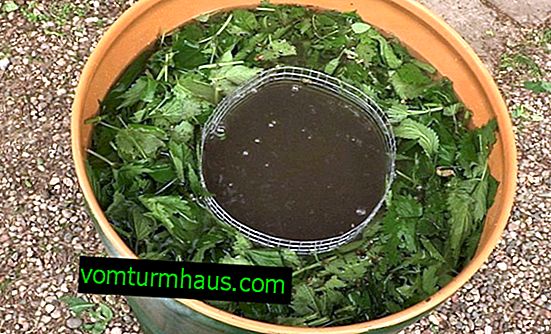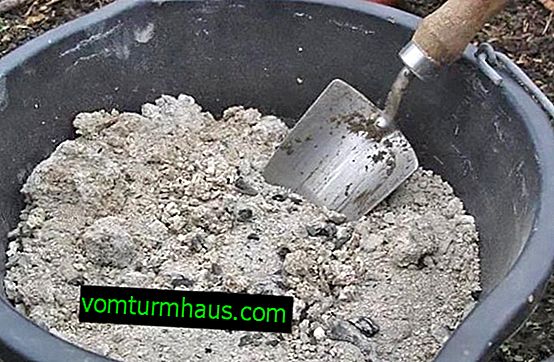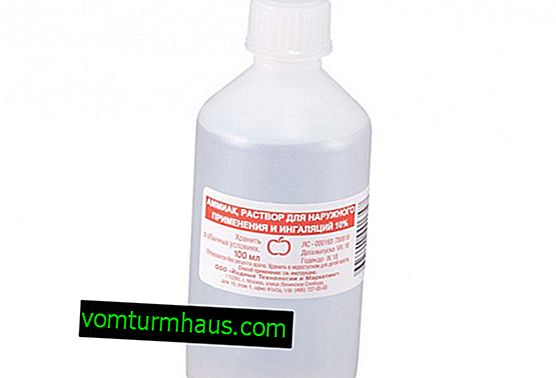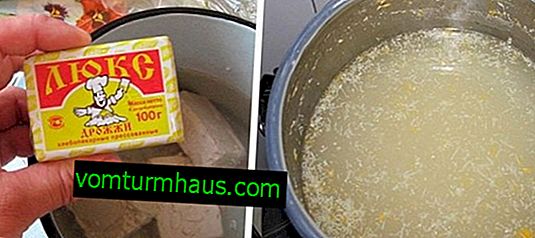How to feed and how to water garlic after winter
A modern system of intensive cultivation of garlic provides for planting crops for the winter. The technique helps to collect a better and richer crop, as well as simplify spring chores on the site. However, it happens that garlic does not please the gardener with either seedlings or a crop. The reason for this is the lack of nutrients in the soil, which can be eliminated by the introduction of complex fertilizers. In our material we will tell you how to properly fertilize garlic, and which plant needs a watering regimen.
Why fertilize garlic
Winter and spring garlic is considered one of the most demanding crops. That is why when growing garlic for the winter, top dressing in the spring is considered one of the most important procedures. It plays the role of an active stimulant, which helps the ascended sprouts grow stronger and instantly give horse growth.
We recommend finding out why garlic turns yellow in spring. Fertilizing helps plants acquire immunity and resistance to adverse environmental factors, which directly affects the crop yield. In addition, strong and developed plants quite often are able to cope with developing weeds on their own, taking a dominant role in the cenosis. This only positively affects the development of culture and helps to form the largest possible fruit.

Thanks to spring top dressing in plants, the digestibility of heavily extracted substances from the soil increases. In addition to increasing the volume of root crops, this helps to improve the aromatic qualities of the vegetable, so that its market price rises significantly. Without complex feeding, the efficiency of crop cultivation decreases, and the resulting crop quite often does not meet modern agricultural requirements.
Important! Abuse of spring dressing is not recommended. In addition to activating cultivated plants, the procedure can cause weed growth, and this can destroy the entire garlic plantation.
Basic feeding rules
Most farmers fertilize almost uncontrollably. Despite the increase in the aerial mass of plants, this does not always have a positive effect on the volume of crops and their quality. In order to grow really large garlic, you should definitely not only adhere to the amount of fertilizing, but also know when the most favorable time comes for the procedure.

When spring feeding, you must adhere to the following rules:
- The first fertilizers are applied to the soil 2–2.5 weeks before planting; this improves the effectiveness of spring top dressing.
- Fertilizers are selected based on the needs of plants for certain nutrients, which is due to the type of soil and its properties.
- Top dressing should be comprehensive, the introduction of certain substances is ineffective and inappropriate.
- Fertilize the beds during the cool, early in the morning or in the evening, this helps to avoid the volatilization of substances under the influence of solar ultraviolet radiation.
- When applying dry fertilizers, the soil must be watered, otherwise their digestibility is reduced significantly.
- Dosages of certain substances should be strictly observed, otherwise they can cause chemical burns to plants and their death.

Spring dressing of garlic provides three consecutive stages of the procedure:
- The first time the beds are fertilized 5-10 days after the snow has melted. This helps plants activate growth and strengthen. The most necessary during this period are mineral preparations based on urea or other urea compounds.
- The following dressing is introduced 14–20 days after the first. With its help, the gardener can achieve the active formation of garlic heads. All kinds of liquid solutions consisting of potassium and phosphorus are best suited for this.
- The last spring top dressing is introduced in early June. It helps to avoid the early formation of arrows on garlic, which inhibit its yield. In order for the heads to be large, the plant must be protected from nitrogen compounds. The most common remedy for this is ground wood ash.
Fertilizers for garlic after winter
Almost any concentrates used in modern agriculture are suitable for feeding garlic. Most often, this plant is fertilized with all kinds of organic and mineral fertilizers. However, sometimes popular methods are also used using fairly specific means.
Video: Spring dressing of garlic
Organic
Plants respond most favorably to organic fertilizing, which is explained by the fact that they contain compounds and nutrients close to the humus layer. They consist of natural components and are derived from plant or animal residues.
Did you know? In ancient India, garlic has been used as a medicinal plant since time immemorial. At the same time, they did not eat it, because it was believed that the culture has an excessively harsh aroma.
For these purposes are used:
- Manure - it is scattered across the territory of the garden, at the rate of 1-3 kg / 1 sq. m, then carefully dig up the soil.
- Chicken droppings - they are introduced into the soil in the form of a solution (1 kg / 7–10 l of water) or in pure form (no more than 1–2 kg / 1 sq. M).
- Mullein solution - an aqueous solution of cow manure, at the rate of 1 kg / 7 l. It is used for watering the entire garden, including row spacing.
- Compost - rotted remains of vegetation or food waste. Such a mixture is scattered throughout the plot with a uniform layer (2-3 kg / 1 sq. M), and then the beds are dug up.
- Peat - make it at the rate of 1-3 kg / 1 sq. m

Most often, such fertilizers are used for poor soils with a low coefficient of humus (sandy, clayey, etc.). They provide an opportunity to improve the structure of the substrate and enrich it with important nutrient components. In addition, organics is an indispensable regulator of soil pH, which is very important for the yield of garlic.
Mineral
Today, the market for specialized fertilizers is full of all kinds of mineral fertilizers. They bring them into any kind of soil, however, the greatest effect of mineral fertilizers is observed in areas with a high content of humus (chernozem). They make it possible to eliminate the deficit of the most important elements for plant development, as well as saturate the soil with all kinds of micro and macro elements.
See also how to properly process garlic before planting. Before choosing one or another type of mineral compounds, it is necessary to evaluate the general condition of the site. For this, it is necessary to carefully analyze the following factors affecting the concentration and leaching of nutrients:
- total soil fertility;
- soil acidity;
- bed illumination;
- predecessor culture.

Based on this, solutions are added to the bed with garlic:
- carbamide (50 g / 10 l of water) - the most beneficial for soils poor in nitrogen;
- nitrophoski (100 g / 10-12 l of water) is a universal source of nitrogen, phosphorus and potassium for soils poor in these elements;
- nitroammophoski (60 g / 10 l of water) - saturates the soil with easily assimilable phosphorus compounds, as well as nitrogen and potassium;
- superphosphate (60 g / 10-12 l of water) - is used for soils poor in phosphorus, with a neutral pH.
Folk remedies
In the national economy, there are many well-known ways to fertilize garlic, suitable for use on any soil. The most common are:
- Nettle infusion - for its preparation, a 100 liter capacity should be filled to the top with freshly cut nettles and filled with water. After that, 250 g of sugar is poured into the container, in this form the mixture is infused for 2–5 days, after which it is used for watering the beds.

- Shredded wood ash - on its basis, aqueous solutions are prepared (200 g / 10 l), which are abundantly watered on the root zone of plants, as well as row-spacings. Feeding with ash not only plays a nutritional role, but also helps protect garlic from all kinds of pests.

- Ammonia - a weakly concentrated solution (25 ml / 10 l of water) is prepared from pharmacy ammonia, which is watered abundantly in the soil.

- Sawdust - wood residues crushed to a powder state are scattered abundantly over the site (1-2 kg / 1 sq. M), after which the soil is carefully dug up. This fertilizer is ideal for heavy soils, as it gives the soil excellent porosity.

- Nutritional yeast - prepare top dressing by infusing 50 g of live yeast in 1 liter of warm water for 2-3 hours. After that, the solution is diluted in a ratio of 1: 5 and used for irrigation. Fertilizer with yeast after the snow melts is especially useful, as it helps young plants to take root and become saturated with vitamins.

Basic watering rules
Watering is one of the main conditions that will provide garlic not only growth, but also effective interaction with fertilizers applied to the soil. With proper watering, water is evenly distributed in the thickness of the soil, which provides plants with fertilizers, and also helps them develop a healthy root system. It also helps garlic to form a large and fragrant onion, as well as saturate it with all the nutrients.

To ensure proper watering of beds, you should:
- make water in large portions;
- carry out the procedure no more than once every 3-4 days;
- at temperatures below +15 ° C completely abandon the procedure;
- during hot periods, provide the beds with watering of at least 9–11 liters of water / 1 sq. m;
- avoid watering with a strong stream (this leads to damage and death of garlic);
- make water only in the basal zone (wetting the leaves can cause fungal damage to the green mass);
- protect plants from watering in the open sun (drops of water on garlic play the role of a lens, which causes burns of delicate leaves).
Useful tips for a good harvest
Usually the above recommendations are enough to ensure a high yield of garlic. But to achieve maximum production volumes and improve its quality at times is possible only if the following tips are observed:
- Avoid top dressing with fresh manure: it not only dissolves worse in the soil, but also differs in components that are rather heavy for plants to absorb.
- Top dressing should be based on both organic and mineral fertilizers. This increases not only the crop yield, but also its aromatic and taste qualities.
- With a rainy spring, watering should be reduced or completely abandoned.
- If you live in regions where snowy winters are frequent, garlic will not need watering until early May. In this case, soil moisture is enough for the safe growth of plants.
- Garlic should not be grown in one place for more than one season, so the main rules for crop rotation must be observed on the site.
- The culture is quite susceptible to weeds, so garlic beds need to be weeded periodically.

Timely dressing of garlic is one of the main conditions that ensures high yield and quality of the fruits of the crop. The most important in this regard is spring top dressing, with its help garlic activates its growth and strengthens after snow melts, which further protects it from all kinds of changes in the environment. A huge number of preparations are used today to fertilize the culture, but the greatest efficiency of the procedure is observed when all the nutrients and minerals that are important for plants are integrated into the soil.








